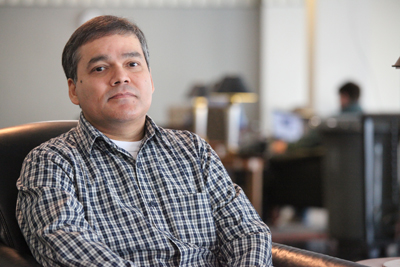Ph.D. Student
by Stephanie Lang
On the evening news, it is not uncommon to see polls charting public opinion on a variety of topics. The number of polls tends to spike around presidential elections, especially with topics surrounding approval ratings, national issues, and the economy. The degree of voter anger, angst, or contentment prominently posted in the polls is often a barometer of the larger political climate. And as you can imagine, those polls and resulting nightly news conversations can spark heated, informative, and oddly entertaining debates on the state of national politics.
But what trends can be found in poll numbers gathered in an increasingly media-saturated world? How do these poll numbers and nightly news conversations, for example, impact the way voters respond in presidential elections and how do voters react to pressing issues such as the economy?
UK political science doctoral student, Ramesh Sharma is looking at this complicated topic in order to see how the national news media and topics like the economy factor into how people vote in presidential elections. The bulk of his research has centered on more recent elections, which have chronicled significant swings in voter leanings and dramatic shifts in political power.
“I’m really interested in how people form perceptions of the economy, especially how exposure to the news affects how they see the economy,” said Sharma. “Basically, how resistant are people to new economic information? Do they update their evaluations when they get new information or do they ignore the news they don’t like.”

Utilizing a wealth of voter information, Sharma’s examination of presidential elections allows him to see whether or not new information can shift voter opinion in an unbiased way or if they distort it to fit their prior beliefs. Looking at opinion data over time, Sharma can determine which of two models of voters is more accurate: Are voters blind partisans, who interpret all information in terms of whether it helps or hurts their party, or are they Bayesian learners, who can change their views in response to new information?
“In many cases, their views remain the same but in certain cases, like the 2008 election where the news media emphasized how bad the economy was, it looks like there is a limit to how stubborn people can be in their political views,” Sharma said.
His interest in public opinion has also led to his involvement in QIPSR (Quantitative Initiative for Policy and Social Research) which is headed by UK political science professor, Mark Peffley. QIPSR, based in A&S and launched in 2010, provides a research infrastructure for UK quantitative social scientists with a broad policy focus.
“Although most of the activities this year are scheduled for spring and early summer, it’s clear that Ramesh and other students in the quantitative social sciences will benefit hugely from the opportunity to meet world class scholars who are invited to present their research at UK,” said Peffley. “QIPSR will offer statistical workshops where students can learn cutting edge methods to understand complex social problems, organize events to encourage external funding for their research, and bring social scientists at UK together to find solutions to problems that span several disciplines.”
>>Visit the QIPSR Blog
Always inquisitive on the subject of public opinion, Sharma also serves as an editorial assistant for Political Behavior, which is co-edited by Peffley. Sharma is able to use the skill set developed from his dissertation work on the journal, which publishes empirical research on mass political behavior in the United States and other countries.
“Ramesh is an extremely hard worker who absorbs new theories and methods like a sponge and uses them with his own unique twist to solve politically important empirical puzzles,” said Peffley.
With the economy still in the tank and another presidential election on the horizon, Sharma will undoubtedly have plenty of emotionally-charged data to sift through for future research.
“The most exciting aspect of this project is the process itself,” said Sharma. “This is not a topic that is so abstract it has little real-life relevance. Being able to connect it to everyday issues and see how people receive the information, how it informs their opinions, is fascinating.”
